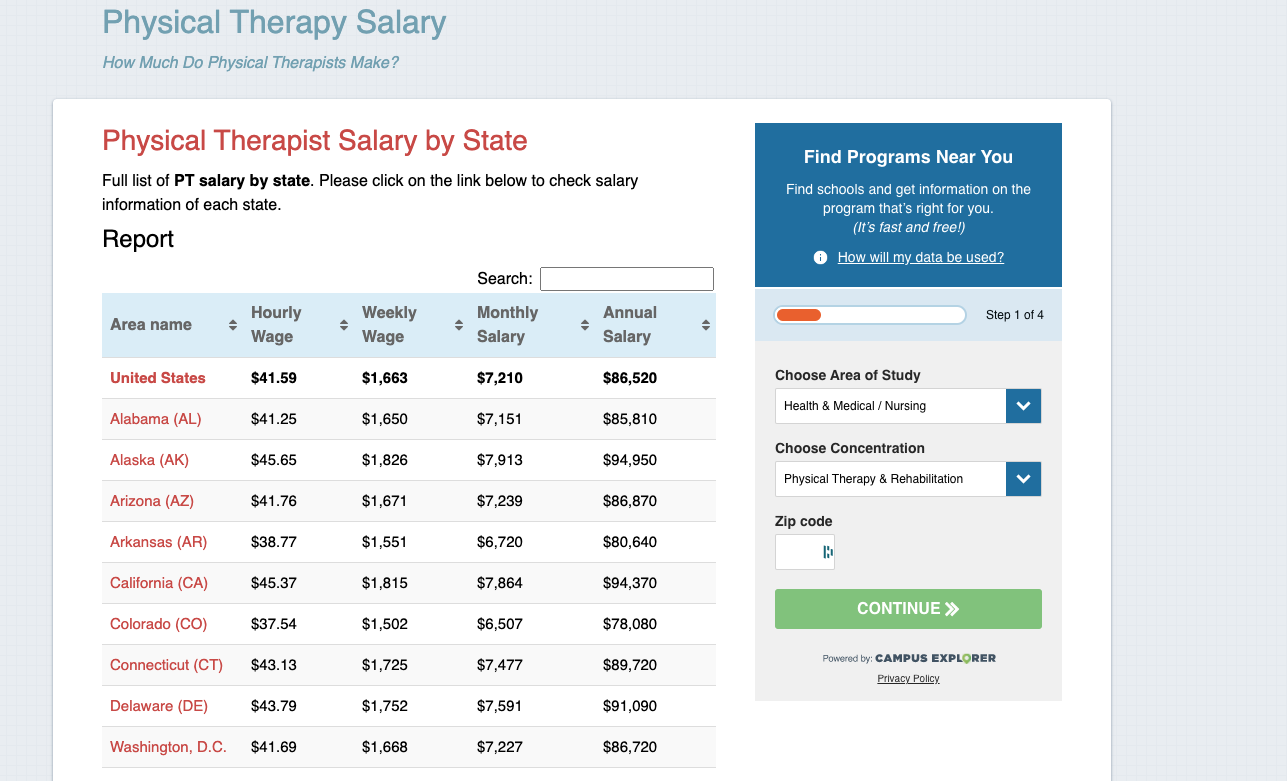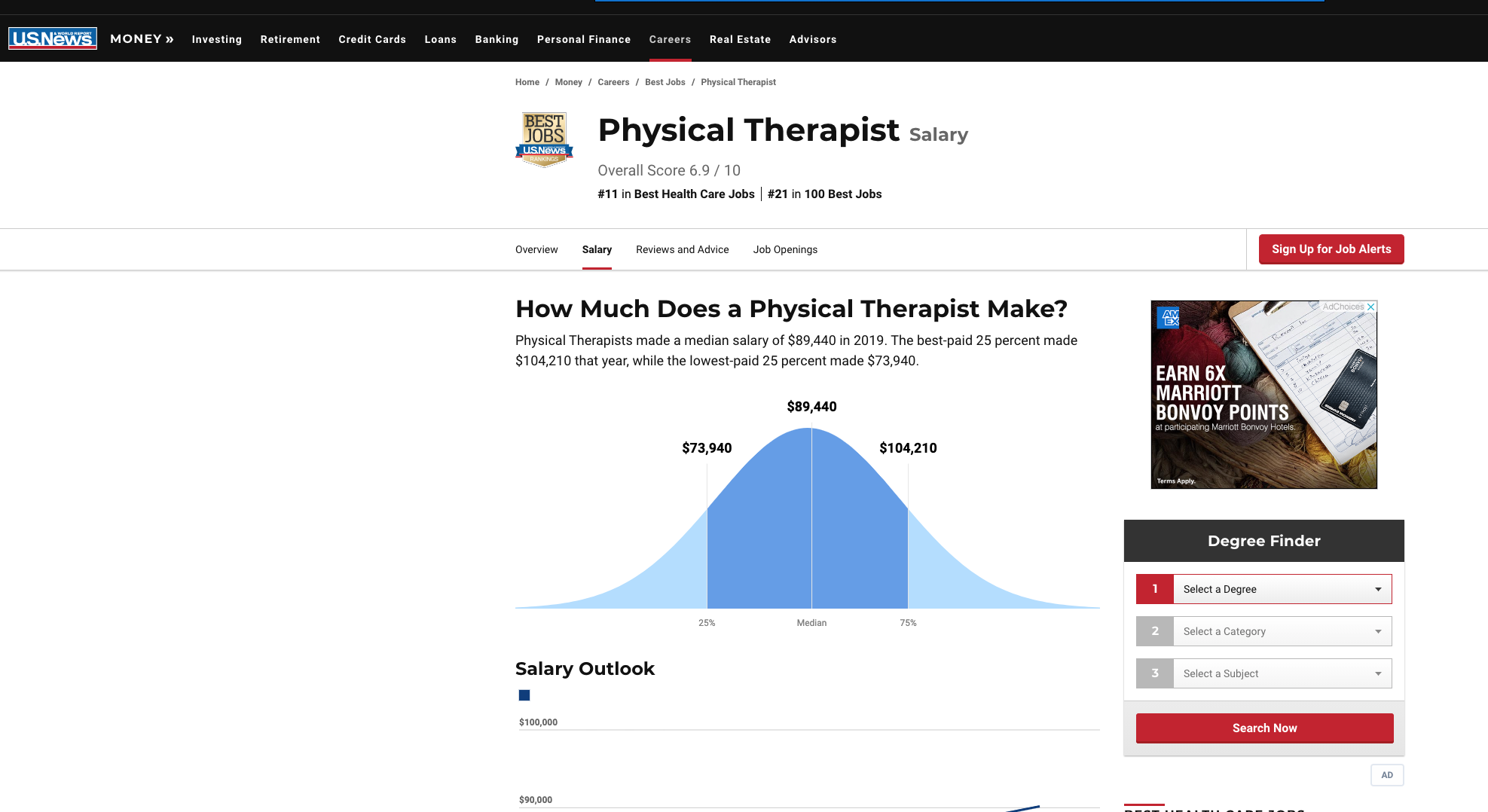Physical Therapist Salary Review Guide 2021
What are the factors that impact a Physical Therapist Salary?
As a physical therapy practice owner or manager, it’s clearly important to know what type of physical therapist salary is most appropriate to pay a new hire into your practice. Sometimes it may feel like a shot in the dark to select a salary to meet the needs of your new physical therapist; and negotiations may also play a part in the final outcome of what their salary may be. But in order to get started without shooting in the dark, there are many tips we can give you to help make this decision clearer and on par with what is smart for your practice.
There are so many variables to take into account when determining a physical therapist’s salary and what is appropriate for your practice. Not every physical therapist can fit into a perfect mold when deciding on a salary. Here are a few major factors to consider when making a decision.
Geographic location can play a big role as to what becomes “typical” for that area of the country. Throughout the United States, the cost of living can be widely variable. For example, if you live in Manhattan in New York City, the cost of rent is going to much higher than if you lived in Harlingen, Texas. The Cost of Living Index from 2019 measures differences by region in the cost of consumer goods and services. The results from this study was based off of housing, utilities, grocery items, transportation, healthcare and other miscellaneous goods and services. The needs of a physical therapist living in each of these areas of the United States might be the same, but the cost of these needs can be drastically different. Therefore, salaries are going to be reflected this way.

The number of years of experience that a physical therapist has under their belt is one of the bigger factors to consider when determining physical therapist salary. The therapist’s level of education can also play strongly into what you’re looking for in your practice. There are still physical therapists in the field that have only a bachelor’s degree. A Bachelor’s Degree in Physical Therapy became required in 1960. Today, licensed therapists are grandfathered in at this 4-year degree level, but they sure do have a lot of experience at this point! Most of these therapists have been practicing PT since the 1980’s and 1990’s. In January of 2002, students were now required to obtain a post-baccalaureate, or master’s degree program, in physical therapy. Even though a master’s degree was now required of all programs across the United States, there was talk of a Doctor of Physical Therapy post-baccalaureate program well before this time. However, it was not until 2015 that these programs became required in order to sit for the national board examination.
Considering Degrees
Why is it important to note the varying degree levels when talk about salaries? In 2020, we see physical therapists that are still practicing with all 3 of these levels of education. As an employer, we weigh the pros and cons of many years of experience versus further education and training. Physical therapists that hold a bachelors or a master’s degree not only have more experience under their belt and have seen a lot more than a new DPT graduate, but they also have been required to attain many continuing education credit hours during their years of practice.
On the flip side, newer graduates of DPT programs have more extensive educational training that puts them at more of an advantage for being up to date with cutting edge research. So which type of therapist warrants more money? That my friend, is up to what the needs of your physical therapy practice might be at the time of hiring. If you’re looking for a new, fresh perspective on new treatment models, then a DPT might be the right fit for you.
If you’re looking for someone that has many, many years of hands-on experience working with patients of all kinds, someone that can be a leader in your clinic and help train others, then you’d be more inclined to lean towards a seasoned therapist. A major factor to keep in mind when making the determination between these categories of therapists, is that insurance pays what insurance pays. If you are an in-network insurance clinic, you are going to be paid at the same rate for a patient treated by a new graduate with a DPT degree as you are for a very experienced PT.
Click the image below to see Physical Therapist Salary comparisons for all 50 states.

Physical Therapist Salary Considerations for Role Diversity
The role of a physical therapist can be extremely diverse. There are opportunities to work in hospitals, skilled nursing facilities, assisted living facilities, on the sports field, in patients’ homes, in outpatient centers or private practice clinics, and other niche areas where physical therapists are needed. Let’s be honest here. The less desirable of a setting to work in, the higher the salary is going to end up being. It’s another basic case of supply and demand. Most skilled nursing facilities aren’t the desired setting for the majority of licensed PT’s. Luckily the reimbursement for PT services in this setting is higher, to then be able to attract more therapists with a higher salary for the job.
Typically, the lower salaries for physical therapists are going to reside in non-hospital outpatient clinics. Private practice physical therapy offices have a lower insurance reimbursement, placing more of a capitated amount on what their therapists can make. But what’s the trade off? Working for a family-centric environment allows you to be part of something bigger and truly take ownership and pride in what you do. It also gives you a really good sense of community. You’re not just a number for some big corporation; you’re a therapist that truly makes an impact in people’s lives throughout your community. So it’s believed that these types of settings are a bit more desirable for this reason.
Experience Matters
The amount of experience that a physical therapist has out in the real world is not the only factor that contributes to physical therapist salary. The type of experience they have is also crucial. If you are a hospital administrator looking to fill a full-time physical therapist position, would it be helpful if your candidates only had home health or outpatient experience? Even if that was 20 years of experience. Probably not too much. They have a ton of experience, but it’s not relevant to the setting they are now applying for. The same goes in reverse. If you’re looking for a candidate for your outpatient orthopedics practice, then years of hospital physical therapy isn’t quite the same.
Now that you have a basic understanding of what makes your potential candidates worthy of different salaries, let’s take a look at how you should be determining what your practice can actually afford. It is clearly important to make sure that you are not overextending yourself and your practice when it comes to paying an employee. A PT candidate may be worthy of a large salary based on all of the key factors above, but if your practice cannot support it, then it could really hurt your business.
Key Performance Indicators
- Cost Per Available Visit: The first important KPI (or key performance indicator) is what your cost per available visit is worth. How do you figure this out? You first need to know exactly what your fixed and variable expenses are on a daily basis.
- Fixed Costs: Fixed costs are things like rent, a cleaning crew, internet or Wifi, EMR (electronic medical records), faxing costs, and so forth.
- Variable Costs: Your variable expenses are things that may change month to month. Your electric bill may change month to month due to summer or winter months and the demand on your air conditioning unit. You also will have variable expenses on marketing efforts in your office, on office supplies or new equipment, or on maintenance. Hourly wages for employees may be variable or fixed depending on if your employee’s schedule fluctuates at all throughout the month. But you must remember that any admin or receptionists’ wages are super important to count as an expense when it comes to your bottom line. Once you have added up all of these typical costs, then it is helpful to break it down by the business day. You can do this on a month to month basis if you prefer. December may warrant a higher cost per slot because there are less business days that your practice is open because of the holidays. You also may find that your staff tends to take more vacation and time off during the month of July, so there may be less employee costs during that time, but also less appointment slots available for patients.
Once you have figured out just how much each treatment slot is costing you, or finding that break-even point, then you want to look at what the revenue looks like that you are bringing in per slot. Now, we know this can wildly vary from one insurance company’s fee schedule to another; so just select an average based on the total amount of collections you are bringing in. Keep in mind, this number can change based on seasons. For example, in Florida the winter months tend to bring in more Medicare patients that live up north in the summer. If Medicare reimburses more from October through March than your average PPO payer, then this is super important to make note of when determining a salary and what types of patients that new hire therapist would primarily be treating.
Rule of thumb tends to be that you do not want to give up more than 35% of the slot cost revenue. Part of this will account for the changes and unknown expenses that may come up from time to time. Who knows when your treatment plinth will need replacing or when your treadmill will go kaput? But the biggest thing to factor into this is growth. If you start out a physical therapist pulling in 33% of the slot revenue, how can you grow that over time if you want to cap them out at 35%? And how in the world can you have enough money to put back into the company to grow the business?
Examples of Physical Therapist Salary in the USA
Let’s take a look at some salary examples here for physical therapists in the United States. According to an article written by U.S. News in 2018, the median salary was $87,930. You can also see the steady increase of the median salary from 2010 to 2018 is pretty significant; more than a $10,000 median increase in 8 years. If you are to break down those numbers to see if it would fit for you, what would that look like? Let’s say our cost per slot is $50. Remember, this is taking into account all of our fixed and variable expenses. Now, let’s also say that our average reimbursement for a single physical therapy treatment is $75. Right off the starting line, our profit is then calculated as $25 on average for each treatment slot. Now keep in mind, our fixed expenses should include that hypothetical salary you are to be paying the new hire physical therapist. So how do you do that? You are going to take the $87,930 per year and break it down to essentially what you would be paying per day for that new employee. You would get a rounded figure of $338.20 per day of added cost for this therapist. However, you must now add in your additional available patient slots in the schedule. If that therapist is going to have 12 slots each day, then for each slot you would paying them $28.18. Now if you add that number to your slot cost prior ($50 + $28.18), you would be at $78.18. If your average reimbursement of $75 does not go up for any reason, then you would be losing money each visit that new therapist is there if you decided to pay them that salary. So now you must go back to the drawing board!

Most people know that in the sales industry, employee salaries are initially lower and the rest of their income comes directly from their performance as a commission. According to Harvard Business Review, a “60:40 pay mix is the average for U.S. sales forces, but the mix varies across industries and sales roles. A very aggressive mix (say 0:100) is common in industries such as insurance that use independent contractors as sales agents. A less aggressive mix (say 75:25) is typical in industries such as pharmaceuticals that want salespeople to focus on customer education, and for technical sales jobs that have a large problem-solving component”.
This type of payment may be new or completely foreign for the physical therapy industry, however, it’s not something new to the medical field as a whole. Dentists, dental hygienists and physician assistants are a few healthcare professionals that have already converted to a salary plus commission based pay. The first thing that needs to be clear, is how a physical therapist would gain commission? PT’s are not salespeople. PT’s do not pedal items door to door, or office to office. So how do we view this foreign concept in the PT industry. Commission can be considered a percentage of the revenue brought in from insurance reimbursement for that particular patient visit. You also can gauge commission off of the number of patient visits a therapist is seeing each day/week/month. It can also be a percentage of what a self-pay patient may spend in your practice. Some physical therapy practices also sell items and other services in conjunction with a patient treatment, such as dry needling and laser therapy, or even therabands and foam rollers. So how does this work? There are 6 basic types of commission plan options that can be structured to make sense for a physical therapist.
6 Basic Types of Physical Therapist Salary Commission Plans
- Base salary plus commission. This type of payment model sets a base guaranteed salary for the therapist. Then it is up to the practice owner to define the terms of how commission is gained. For example, the physical therapist has a base salary of $50,000 and they receive a percentage of what revenue they are bringing in each week. They also receive 10% of all items purchased in the office per their recommendation to patients. So essentially you are guaranteeing $50,000 and it’s up to the therapist to work hard and determine what else they bring in.
- Straight commission plan. This type of model seems to be a little more difficult to pull off quite honestly if you are hiring a full-time physical therapy. However, if you are planning to bring someone in as a 1099 employee, then this might be more doable. A 1099 PT could then be paid a percentage or flat rate for each patient they see.
- Relative commission plan. A relative commission plan is when a target or quota is defined ahead of time. The physical therapist would have a base salary and once they have met their quote that was established, they are paid commission on top of that. For example, if their quota was to bring in $40,000 per month and they met that or exceed it, they would get an additional $2,000 that month. If they only met the quota at 85%, then they would receive 85% of that commission. This could work really well on a team basis also.
- Absolute commission plan. This type of plan is based on a commission for each new patient that is brought in. You can still have a baseline salary for the PT, but this incentivizes them to market themselves outside of the office.
- Straight line commission plan. This type of plan follows the relative commission plan, but it tends to reward over achievers better. If someone reaches past their quota, then their commission would go up.
- Tiered commission plan. A tiered plan allows for the practice owner to establish multiple milestones to achieve in order to gain more commission. For example, if a PT sees 40 patients per week they are paid 10% of the revenue brought in. But if they see 50 patients that week, they get 12% of the revenue. This type of model encourages those therapists that constantly reach their goals to do even more; in turn being rewarded for that.
There are certainly many pros and cons to building a commission style payment model for your physical therapist salary. As a practice owner, it’s up to you to determine which outweighs the other and what is going to work better for the needs of your company. But let’s explore some of the positive and negative attributes of establishing some variety of commission-based salary model for your therapists.
PROS:
- You are able to reward high performers for their ability to work hard and excel in your practice. Instead of working a part-time job on the weekend to pay off student loans, they now have a tool to work on to become more productive in your practice. It’s a win-win.
- Lower performed will not be paid to just sit around.
- PT’s will no longer celebrate with patients cancel or no-show. An open slot for them means less money in their paycheck at the end of the day.
- Therapists that are fast with their paperwork are rewarded since all their time is considered commission worthy if with a patient. Therapists that are slow with paperwork are no longer dragging down the company and asking for documentation time.
CONS:
- It can be time intensive tracking and calculating percentages and performance numbers. If you have a good system to easily pull all these KPI’s, like HENO, then this no longer becomes much of a con for utilizing a commission model.
- It can be confusing for your therapists to know where they stand. If there is not a good system in place for the therapist to follow where they are, then they can be left in the dark until payday.
- It is not quite as cut and dry when explaining your offer to a potential new hire. It’s very easy to say “we’re offering you $73,000 per year”. You will need to put together an easy way to allow new hires to understand and estimate what they will make. But even then, it’s not a guarantee.
Finding the right candidate for your physical therapy practice is crucial and taking into account all of the above variables and options can be a time intensive task. Weighing your options for each candidate and what will be best for the clinic is important no matter what size practice you have. But spending the time to mull over your options and calculate numbers that will work for each party will be worth it in the long run.
If you’re looking to hire a physical therapy assistant, you may find that many of the factors above will also come into play when hiring and figuring out the best compensation model. Physical therapy assistants have a 2-year associates degree from an accredited school. All over the United States these types of programs are popping up and putting more and more licensed clinicians into our profession. These medical professionals support the physical therapists and help carry out the plan of care that was put together for each patient. PTA’s work in all the major settings that PT’s work in; hospitals, skilled nursing facilities, outpatient therapy centers, home health practices, assisted living facilities, hospice and even in doctor’s and chiropractor’s offices. In order for these licensed healthcare providers to work, they must be overseen by a licensed physical therapist, physician or chiropractor.
A lot of the same factors come into play when determining a payment structure for physical therapy assistants. In certain parts of the country you may find that PTA’s can make almost as much as a PT, even with a 2-year degree. If you factor in a setting that is in high demand for needing clinicians, in a setting that receives higher insurance reimbursement with a PTA that has many years of experience in an area of the country that needs therapists badly, you may find much higher wages for PTA’s.





